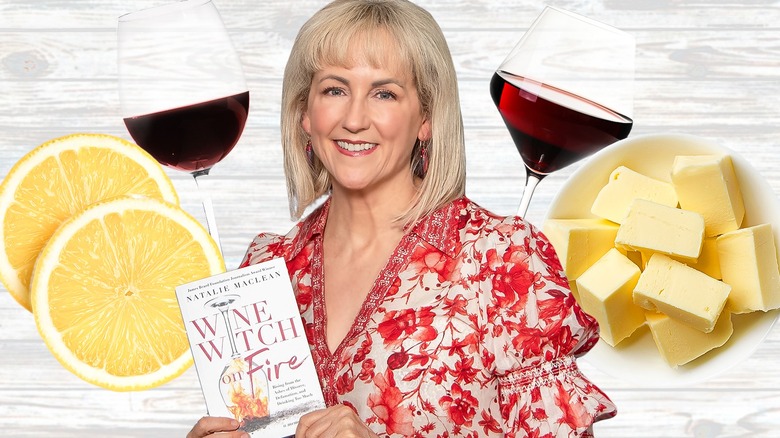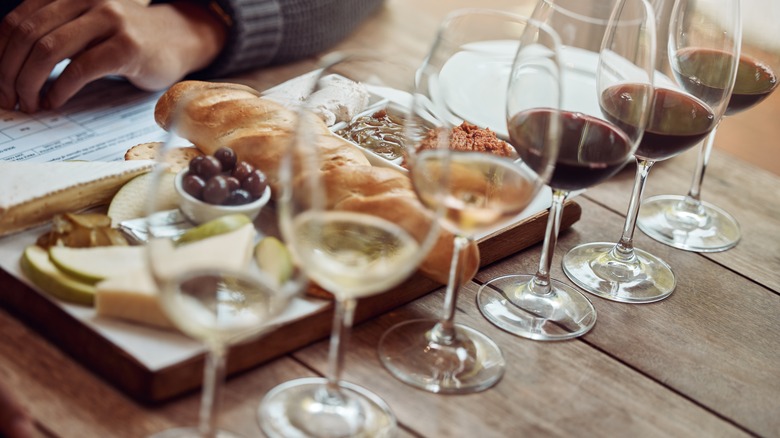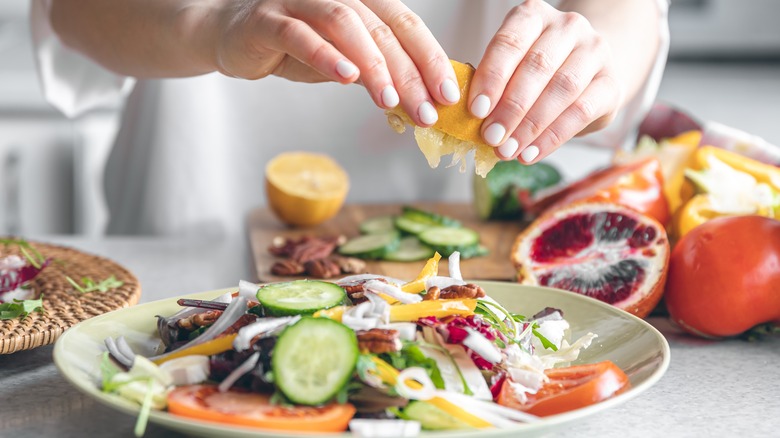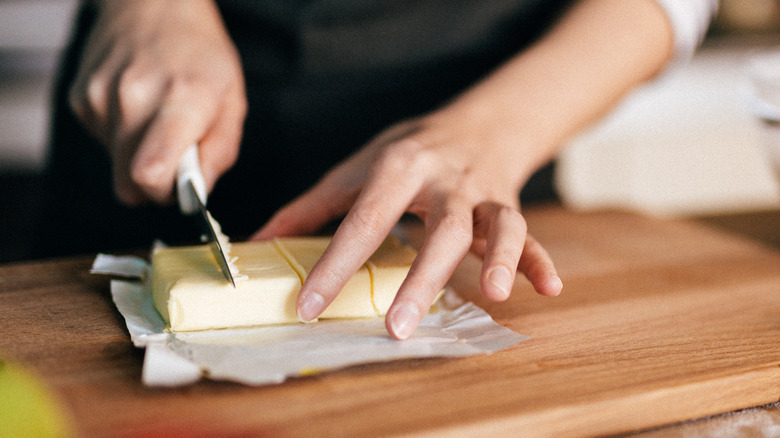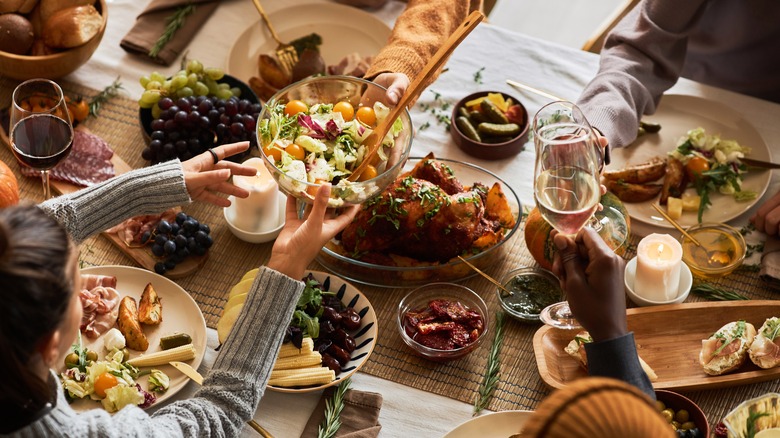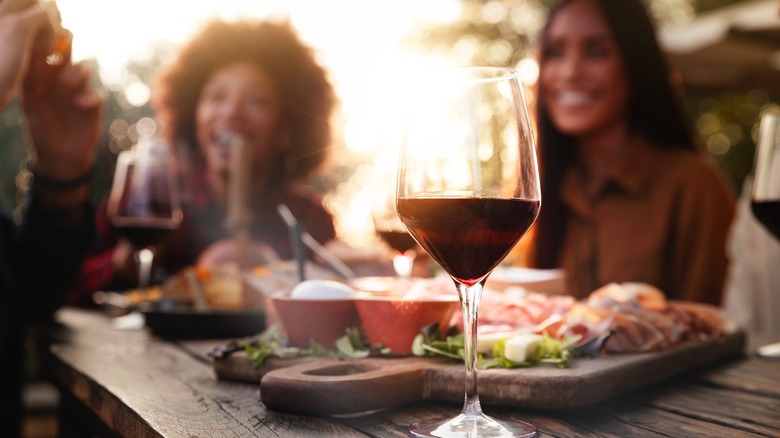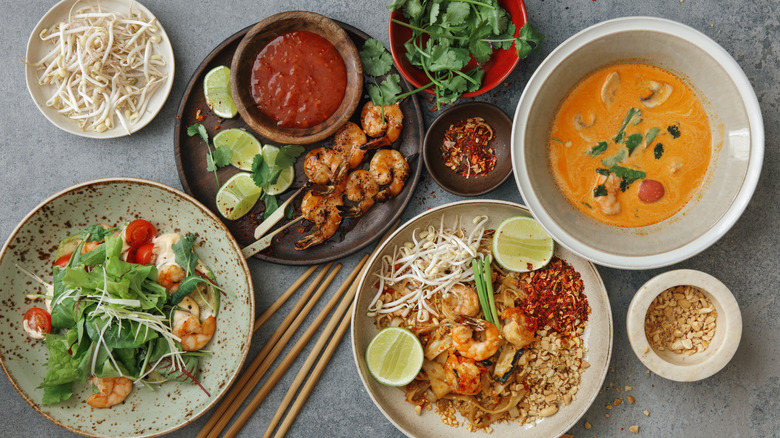An Expert Explains How To Use The Lemon Or Butter Test To Choose Your Wine Pairing
Whether you enjoy wine as your drink of choice at the bar or prefer to sip on a glass with dinner, making a selection can take time and effort. Perhaps you're shopping for a bottle of wine and unsure of what to pick, or maybe you're looking at a restaurant's wine list and trying to narrow it down based on your meal choice. Either way, it can sometimes feel like you need formal wine training to make sense of it all.
I spoke with wine expert and writer Natalie MacLean, who has picked up numerous tips over years of teaching food and wine pairing courses. Her lemon or butter test provides easy advice that will hold up whether you're a complete novice or a burgeoning expert yourself. The basis of this method is straightforward and doesn't require additional training.
When seeking out the perfect wine for a meal, just ask yourself whether the dish would benefit from a squeeze of lemon juice or a pat of butter. These contrasting ingredients bring very different qualities to the table, making them a suitable basis to distinguish between two styles of wine: refreshing and crisp or bold and rich. Follow MacLean's guidance to guarantee an easy way to pick your next pairing.
Complementary and congruent wine pairings
Food and wine pairing doesn't have to be a rigid concept without room for customization. The old rule that red wine should be served with meat and white wine with fish has long been loosened, leaving room for multiple interpretations depending on the other components of a dish. No one is stopping you from drinking whatever wine you want with your meal (unless you have a very motivated sommelier), but there are reasons why food and wine pairings are recommended.
The two main characteristics determining optimal matches are whether the flavors are complementary or congruent. In this way, a range of pairings are possible for the same dish, depending on whether you want to enhance certain notes or balance them out. By choosing wines with specific qualities, you can play to these dualities.
Complementary pairings work due to contrasting notes that taste well together, such as caramel and salt. Much like the saying that opposites attract points to diverse qualities combined with success, complementary food and wine pairings work in the same vein. On the other hand, congruent pairings feature similar flavors that come together seamlessly. Recurring aromas are amplified, bringing additional depth to the union between each sip of wine and bite of food.
Lemon test and pairings
The lemon test uses this highly acidic ingredient to determine an optimal pairing. "If you would normally squeeze some lemon juice on your food, such as a light fish dish, then look for a wine that is naturally high in acidity and may even be described as having lemon aromas, such as Riesling, Sauvignon Blanc or a Pinot Grigio," MacLean explains.
Her top suggestion is to pair "a sharp, citrusy Sauvignon Blanc with a lemon-dressed arugula salad, where the wine's acidity dances with the salad's tang." In this case, congruent flavors serve as the basis for the selection. Squeeze a bit of lemon on your dish, and wash it down with a crisp and citrusy wine.
The best way to truly understand food and wine pairings is to experience them firsthand. If you want to get to the bottom of it, consider hosting a mini-tasting party with friends and have everyone bring a bottle so that you can make comparisons. "Take a bite of something lemony to simulate the effect of high acidity in food. Then, choose a wine that stands up to the acidity," MacLean recommends, suggesting, "Typically, a zesty white wine with its own punch of acidity will harmonize beautifully." Whether you're adding lemon to a lighter or weightier dish, the wine will have a palate-cleansing effect.
Butter test and pairings
Butter is the key to richer food (restaurants use a lot more butter than you'd expect) and is often the reason your restaurant meal tastes better than what you're making at home. Use this ingredient as a guideline for your next wine pairing with MacLean's advice: "If you would normally slather some butter on your dish, say a juicy steak, then opt for wines that are buttery, rich and full-bodied themselves, like a full-bodied Chardonnay or a velvety Merlot." This will highlight the overlapping elements in the food, creating an elevated sensation for your palate.
Test it out yourself: "Enjoy a bit of buttery food to represent rich, fatty flavors," MacLean instructs, explaining, "You're looking for a wine that cuts through this richness, balancing it with acidity or complementing it with its own richness." If you're unsure of where to start, MacLean has a reliable pairing to emphasize the luscious nature of a dish. "A rich, oaky Chardonnay next to a buttery lobster," she recommends and describes, "the wine envelops the palate, enhancing the lobster's sweetness." On the other hand, if you're looking to add some freshness to the dish, contrasting it with a complementary wine with acidity to tame the richness is a suitable option, too.
Why do these tests work so well?
With all the information out there regarding food and wine pairings, this easy either-or question seems too good to be true. Yet, unless you're looking for a hyper-specific pairing, it satisfies most situations. "I choose lemon and butter for their simplicity and availability," MacLean says. "Most people have them in their kitchens. They are also quintessential representatives of acidity and fat." While they aren't the only ingredients that represent these characteristics, she adds, "their flavors are straightforward, allowing for a clear contrast or complement when tasting wines."
These ingredients are also incredibly versatile, with qualities that can be translated into a wide range of wines. "While the test initially seems tailored to white wines, it's equally effective for reds," MacLean says. "The butter test, for example, can highlight the luxuriousness of a full-bodied red wine just as well as it does for whites." Indeed, rich buttery white wines are commonly found in warmer climates or in wines that are matured in new oak barrels (which are different from steel). Meanwhile, high-acid red wines are a hallmark of cooler wine-growing regions, offering many of the vibrant elements of a similarly zingy white wine.
Caveats of the lemon or butter test
Of course, with something as varied as wine and food pairings, it's unlikely that one option will consistently be met with satisfaction across the board. "Personal preferences play a huge role. What works as a perfect pairing for one person may not for another," MacLean comments. Her philosophy beyond seeking congruent and complementary matches is to pair wine "with the diner, not the dinner." She emphasizes, "Drink what you like!" Granted, chances are you'll like something more if the flavors mingle together well on your palate.
Although her nifty trick reduces a lot of the guesswork around choosing the right wine to pair with a meal, MacLean concedes, "The complexity of dishes can sometimes require more nuanced wine choices than the lemon or butter test can provide." Ultimately, she says, "It's mainly a starting point, not a definitive guide. Experimenting is key — and fun." A great place to begin is by lining up a few bottles and tasting how they pair with lemon or butter and expanding from there.
Pairing wine with spicy and savory foods
Using acid and fat to guide wine and food pairings is one method, but MacLean offers additional tips if your meal features another prominent element. For example, spicy foods can be tricky to match, as high alcohol and tannins can clash with heat, making the result less than pleasant. "Look for wines with a touch of sweetness (like a Riesling) or a lower alcohol to avoid amplifying the heat," MacLean recommends. Sweetness helps to tame the spice level; test it yourself by sipping on sugar water and taking a bite of a jalapeño... or just pair a German Kabinett Riesling with a Thai curry.
Meanwhile, if you're eating a meal with savory notes and hints of umami, MacLean explains, "A wine with good acidity or tannins can enhance the flavors, making for a great contrast or complement." There's plenty of room to customize the bottle depending on the components of the dish. Look for a zesty white or a bold red to match the dominant ingredients.
